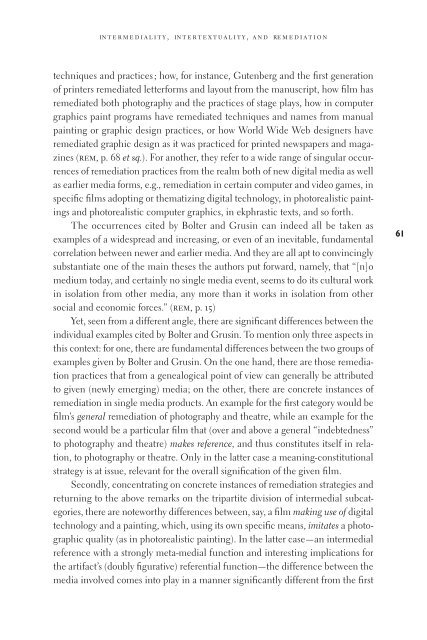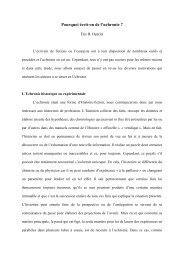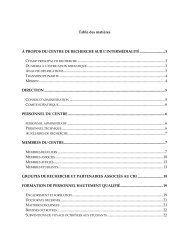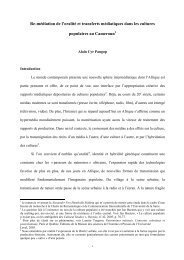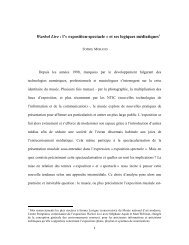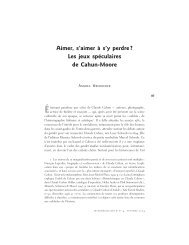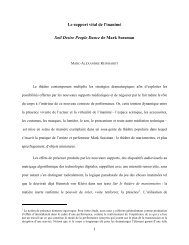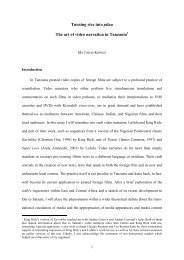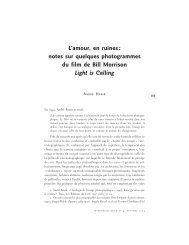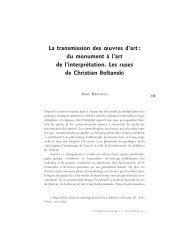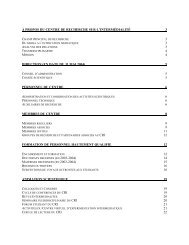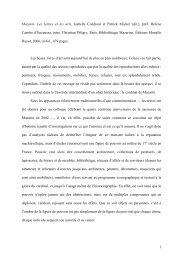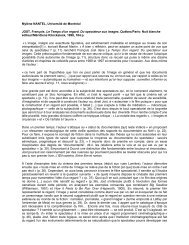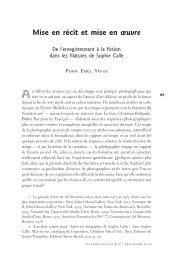Intermediality - Centre de recherche sur l'intermédialité (CRI ...
Intermediality - Centre de recherche sur l'intermédialité (CRI ...
Intermediality - Centre de recherche sur l'intermédialité (CRI ...
You also want an ePaper? Increase the reach of your titles
YUMPU automatically turns print PDFs into web optimized ePapers that Google loves.
intermediality, intertextuality, and remediation<br />
techniques and practices ; how, for instance, Gutenberg and the fi rst generation<br />
of printers remediated letterforms and layout from the manuscript, how fi lm has<br />
remediated both photography and the practices of stage plays, how in computer<br />
graphics paint programs have remediated techniques and names from manual<br />
painting or graphic <strong>de</strong>sign practices, or how World Wi<strong>de</strong> Web <strong>de</strong>signers have<br />
remediated graphic <strong>de</strong>sign as it was practiced for printed newspapers and magazines<br />
(rem, p. 68 et sq.). For another, they refer to a wi<strong>de</strong> range of singular occurrences<br />
of remediation practices from the realm both of new digital media as well<br />
as earlier media forms, e.g., remediation in certain computer and vi<strong>de</strong>o games, in<br />
specifi c fi lms adopting or thematizing digital technology, in photorealistic paintings<br />
and photorealistic computer graphics, in ekphrastic texts, and so forth.<br />
The occurrences cited by Bolter and Grusin can in<strong>de</strong>ed all be taken as<br />
examples of a wi<strong>de</strong>spread and increasing, or even of an inevitable, fundamental<br />
correlation between newer and earlier media. And they are all apt to convincingly<br />
substantiate one of the main theses the authors put forward, namely, that “[n]o<br />
medium today, and certainly no single media event, seems to do its cultural work<br />
in isolation from other media, any more than it works in isolation from other<br />
social and economic forces.” (rem, p. 15)<br />
Yet, seen from a different angle, there are signifi cant differences between the<br />
individual examples cited by Bolter and Grusin. To mention only three aspects in<br />
this context: for one, there are fundamental differences between the two groups of<br />
examples given by Bolter and Grusin. On the one hand, there are those remediation<br />
practices that from a genealogical point of view can generally be attributed<br />
to given (newly emerging) media; on the other, there are concrete instances of<br />
remediation in single media products. An example for the fi rst category would be<br />
fi lm’s general remediation of photography and theatre, while an example for the<br />
second would be a particular fi lm that (over and above a general “in<strong>de</strong>btedness”<br />
to photography and theatre) makes reference, and thus constitutes itself in relation,<br />
to photography or theatre. Only in the latter case a meaning-constitutional<br />
strategy is at issue, relevant for the overall signifi cation of the given fi lm.<br />
Secondly, concentrating on concrete instances of remediation strategies and<br />
returning to the above remarks on the tripartite division of intermedial subcategories,<br />
there are noteworthy differences between, say, a fi lm making use of digital<br />
technology and a painting, which, using its own specifi c means, imitates a photographic<br />
quality (as in photorealistic painting). In the latter case—an intermedial<br />
reference with a strongly meta-medial function and interesting implications for<br />
the artifact’s (doubly fi gurative) referential function—the difference between the<br />
media involved comes into play in a manner signifi cantly different from the fi rst<br />
61


